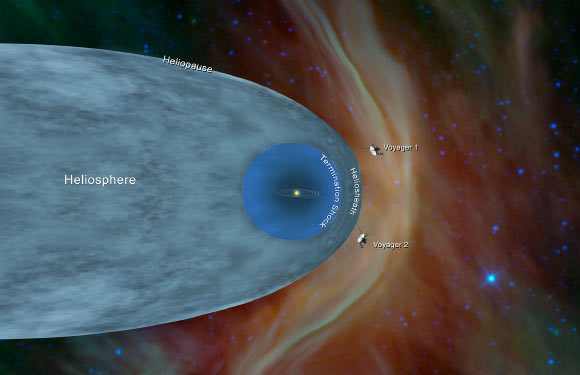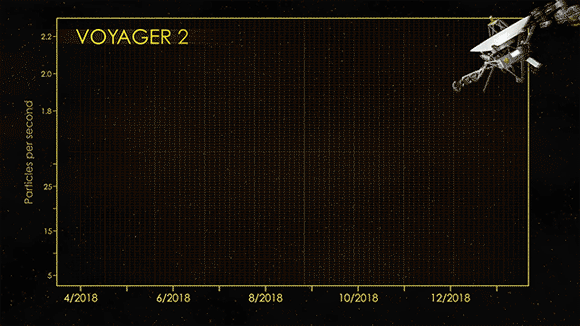Forty-one years after it launched into space, NASA’s Voyager 2 spacecraft has crossed the outer edge of the heliosphere. Called the heliopause, this boundary is where the tenuous, hot solar wind meets the cold, dense interstellar medium. Voyager 2’s twin probe, Voyager 1, crossed this boundary in 2012, but Voyager 2 carries a working instrument that will provide first-of-its-kind observations of the nature of this gateway into interstellar space.

This illustration shows the position of NASA’s Voyager 1 and Voyager 2 probes, outside of the heliosphere, a protective bubble created by the Sun that extends well past the orbit of Pluto. Image credit: NASA / JPL-Caltech.
The most compelling evidence of Voyager 2’s exit from the heliosphere came from its onboard Plasma Science Experiment (PLS).
Until recently, the space surrounding Voyager 2 was filled predominantly with plasma flowing out from our Sun — the so-called solar wind.
The PLS uses the electrical current of the plasma to detect the speed, density, temperature, pressure and flux of the solar wind.
The instrument observed a steep decline in the speed of the solar wind particles on November 5.
Since that date, it has observed no solar wind flow in the environment around Voyager 2, which makes mission scientists confident the probe has left the heliosphere.
In addition to the plasma data, members of the Voyager science team have seen evidence from three other onboard instruments — the cosmic ray subsystem, the low energy charged particle instrument and the magnetometer — that is consistent with the conclusion that the spacecraft has crossed the heliopause.
“There is still a lot to learn about the region of interstellar space immediately beyond the heliopause,” said Voyager project scientist Dr. Ed Stone, a researcher at Caltech.
Voyager 2 now is slightly more than 11 billion miles (18 billion km) from Earth.
The mission operators still can communicate with Voyager 2 as it enters the new phase of its journey, but information — moving at the speed of light — takes about 16.5 hours to travel from the spacecraft to Earth.

Comparing data from different instruments aboard Voyager 2, the mission scientists determined the spacecraft crossed the outer edge of the heliosphere on November 5, 2018. Image credit: NASA / JPL-Caltech.
“Voyager has a very special place for us in our heliophysics fleet,” said Dr. Nicola Fox, director of the Heliophysics Division at NASA Headquarters.
“Our studies start at the Sun and extend out to everything the solar wind touches.”
“To have the Voyagers sending back information about the edge of the Sun’s influence gives us an unprecedented glimpse of truly uncharted territory.”







